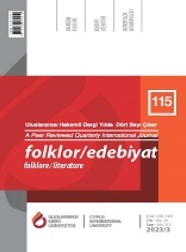Türk Kılıç Dansları
Turkish Sword Dances
Author(s): Erhan Solmaz, Muharrem FeratanSubject(s): Theatre, Dance, Performing Arts, Cultural history, Customs / Folklore
Published by: Uluslararası Kıbrıs Üniversitesi
Keywords: Anatolia; sword; dance; war; folklore;
Summary/Abstract: Folk dances have been classified in various ways in all cultures around the world. War-themed dances occupy a special place in these classifications. The factor that makes war dances special is that they are a powerful tool that holds the spirit of the society they belong to and strengthens the sense of unity. For example, it has been seen that the stance of a hero or the memory of war, which is ingrained in the memory of a society, shapes the stance of all members of that society. Sword dances, one of the armed dances included in war dances, are seen as a symbol of heroism in many cultures around the world. Since that the effect of the sword is directly based on the power of the wrist, the dances performed with the sword have deeply affected the audience as a sign of bravery and valor since ancient times. Sword dances, which are the most common type of war dances, are sometimes performed solo by one person, sometimes by two people, and sometimes by a large group of dancers in opposing lines or in a circle. Sword dances, which are also seen in ancient Anatolian civilizations, are important in terms of forming the origin of European sword dances. Because such dances appear in many cultures ranging from the Hittites to the Phrygians, the Lydians to the Hellenistic period, and the Byzantine civilization. The presence of sword dances is also seen in today’s Anatolian Turkish culture, which was formed by the combination of the “Steppe” culture, which the Turks brought with them after the conquest of Anatolia, with the Mediterranean and Mesopotamian cultures. The main purpose of the study is to reveal what the sword dances seen in today’s Anatolia are and how they are distributed throughout Anatolia. In line with this purpose, in this study, sharp weapons such as wedges, machetes, yams, daggers and knives are explained under the heading of swords in a way that limits them to Anatolian geography. In the study, the document analysis technique, which includes the analysis and analysis of written and visual materials related to the subject, was used. In addition, the images of the related dances were included in the study with the QR code system and the similar features and differences of these dances were discussed separately.
Journal: Folklor/Edebiyat
- Issue Year: 29/2023
- Issue No: 115
- Page Range: 747-766
- Page Count: 20
- Language: Turkish

